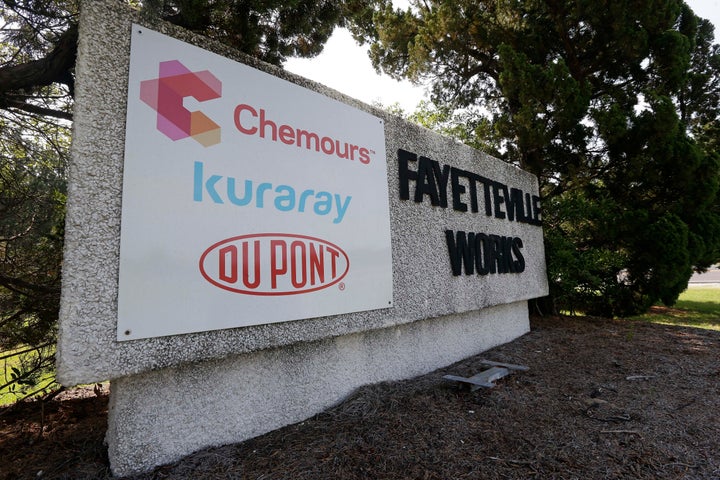In 2009, DuPont touted the chemical produced at its plant along North Carolina’s Cape Fear River as a new, safer alternative to the dangerous per- and polyfluoroalkyl substances, or PFAS, that were behind health crises in Parkersburg, West Virginia, and scores of other communities.
But in the decade after the Environmental Protection Agency approved the chemical, called GenX, for commercial use, high levels accumulated in the river, a drinking water source for about 250,000 people. Thyroid cancer rates in the region spiked along with reports of rare pediatric cancers, leukemia and bladder cancer, according to Clean Cape Fear, an environmental advocacy group. That has stoked fears and frustration among residents who believe regulators have failed to protect them in allowing the chemical to come to market.
Most PFAS — and other toxic chemicals — that the industry sends to the EPA for consideration are ultimately approved with few or no restrictions. The agency recently took what it characterized as “aggressive” steps in providing guidance on PFAS contamination cleanup and other measures, though it hasn’t done anything to limit the chemicals’ production or reduce discharge into the environment.
GenX isn’t the only allegedly safe new chemical in the PFAS family ― a group of about 4,700 chemicals defined by their fluorinated carbon bonds that don’t naturally break down and can’t be fully destroyed ― that is now raising concerns. The ubiquitous chemicals have been used to make thousands of products like Teflon, Scotchgard, food packaging and water- and stain-resistant textiles. An increasing volume of academic and government research has linked PFAS to cancer, liver disease, autoimmune disorders, kidney disruptions and a range of other serious health problems. Research has found PFAS in the blood of 97% of Americans and in the drinking water that more than 100 million people rely on.
Still, the EPA appears poised to approve four new varieties of PFAS in 2020. While the agency has redacted most basic information about the new chemicals in its public documents, New Chemical Notices on the EPA website that were reviewed by HuffPost show these chemicals also present threats to human health.
Among them is a compound that’s “lethal if inhaled” and “corrosive to the skin,” according to an EPA safety data sheet. Several present a “severe health hazard” and are part of a category that includes carcinogens, reproductive toxins or respiratory sensitizers. Brief contact with those chemicals may cause “irreversible injury,” while “life-threatening, permanent, or major injury” can arise from “a single or repeated exposure.”
Though the fluorinated carbon bonds are the distinguishing feature of the PFAS family, the EPA doesn’t regulate PFAS as a unified class. Instead, it mostly looks at each individual PFAS as its own chemical, an approach has angered public health advocates who say the EPA is purposely weakening the regulatory process to allow more PFAS on the market.
Because the entire class isn’t considered during the approval process, Cape Fear’s cancer rates — and dozens of other health crises linked to PFAS nationwide — largely won’t factor into the EPA’s decision.
The process allows chemical companies to keep developing new PFAS with slightly altered structures once their older chemicals are found to be dangerous. The strategy makes it impossible for public health advocates and scientists to keep up with new PFAS, said David Andrews, senior scientist with the Environmental Working Group, an advocacy group that tracks and studies PFAS contamination. He advocates for PFAS to be regulated as a class or subclasses.
“A chemical-by-chemical approach to regulation will take centuries. It will take forever,” he said.
As companies like DuPont-owned Chemours — which recorded $6.6 billion in sales last year — continuously develop new PFAS, critics say the EPA is putting the industry’s interests first.
“When you’re in a hole, the first thing you’re supposed to do is stop digging,” said attorney Jonathan Kalmuss-Katz of Earthjustice, an environmental legal group. “EPA’s continuous approval of new PFAS chemicals is only making their jobs harder and placing more people at risk.”
‘A Black Box’
The EPA, which did not respond to requests for comment for this article, approved at least 15 new PFAS compounds in the last three years, and at least 600 between 2006 and 2016.
A health risk analysis attached to one PFAS chemical the EPA approved for commercial use last November recorded “severe signs of irritation in the respiratory tract and eyes, [and] microscopic findings in the upper respiratory tract and lungs.” Those who come into contact with another new PFAS approved in April risk “irritation to eyes, mucous membranes and lungs, mutagenicity, and respiratory sensitization,” according to an EPA summary.
The agency redacts most health and safety information from its publicly available documents, limiting what we know about the potential risks. (See documents cited in this story here.)
But that regulatory process becomes even more of “a black box” when PFAS compounds are approved through any number of exemptions and loopholes, said Richard Denison, lead senior scientist with the Environmental Defense Fund.
The most common is the low volume exemption, which is granted when companies plan to produce less than 22,000 pounds of a chemical. However, the EPA appears to do little to verify that companies are in compliance, Denison said. In such cases, the EPA also redacts chemicals’ generic names and other very basic information, which makes it impossible to know what type of chemical was submitted or its health risks.
The EPA has said it approved 89% of the exemption requests since 2016.
“We’re really on a complete fishing expedition if we’re trying to learn how many PFAS are approved [as exemptions],” Denison said. “The disturbing thing is, these chemicals go through very quickly with no public input, and the majority are getting approved.”
Instead, the agency often relies on industry science, or it compares proposed new PFAS to similar chemicals already on the market. That can be a problem, Denison said, because it’s difficult to ascertain chemicals’ similarity without adequate testing. Earthjustice also reports that many PFAS already on the market don’t have human toxicity reports in the first place.
“That’s how we got into this problem in the first place, but the EPA hasn’t learned its lesson from the last round of PFAS,” he said. “It still continues to approve new chemicals without enough data to evaluate them.”
‘All Of The Reform Has Been Reversed’
Lax PFAS oversight is only part of the larger story of toxic chemical deregulation under the Trump administration.
Prior to 2016, the EPA’s toxic chemical approval process was secretive and rarely resulted in denials or restrictions on use, Denison said. In 2016, a major amendment to the Toxic Substances Control Act (TSCA) overhauled the nation’s chemical review process. For a brief period after the law took effect, the EPA scrutinized new chemicals, Denison said, and it more frequently required further studies of dangerous substances, or placed limits on their quantity, discharge and exposure. It also significantly slowed down the approval process.
“The EPA started flagging a lot more of these chemicals as problematic and it was requiring more testing,” Denison said.
Then the Trump administration took over. Under then-Administrator Scott Pruitt, the approval process sped up once again, Denison said. The administration also installed Nancy Beck, a former chief of the American Chemistry Council trade organization, in one of the highest positions in the EPA’s Office of Chemical Safety and Pollution.
“Her impact — I can’t overstate it, how negative it was, in our view, and how in line it was with what the chemical industry wanted,” Denison added. “The vast majority of new chemicals are now getting greenlit with no conditions. All of the reform has been reversed.”
The TSCA amendment also required more transparency during the approval process, but in the case of the four new PFAS chemicals currently under review, the health studies, chemical names and other information have not been made public. Earthjustice and the Environmental Defense Fund filed a notice of intent to sue in September to force the EPA to make information for PFAS and other dangerous chemicals available.
The agency’s handling of PFAS highlights the need for tougher laws, said Rep. Rashida Tlaib (D-Mich.), whose district holds several contaminated sites. She co-sponsored the PFAS Action Act, a bill that passed the House with bipartisan support in January. The Trump administration has vowed to veto the act if it passes the Senate, partly because it includes a five-year moratorium on new PFAS.
“We can see very clearly the EPA’s review process has been tainted by corporate greed, and the people running the agency aren’t following its true mission or why it was created in the first place,” Tlaib said.
Meanwhile, the recently approved defense bill included a provision that will ban PFAS in fire-fighting foam, a major source of PFAS contamination, and authorize some funding for cleanup around military bases. California also took small steps toward regulating PFAS as a class.
In the meantime, frustration with the EPA is growing in communities that the PFAS crisis has hit hardest, like those along North Carolina’s Cape Fear River. It’s “foolish and irresponsible” for the EPA and chemical manufacturers to send more PFAS into the world as her neighbors suffer, said Emily Donovan of Clean Cape Fear.
“What’s the end game?” she asked. “They’re making a chemical that they don’t know how to responsibly make or dispose of, and you can’t protect Americans from exposure to it.”
BEFORE YOU GO
Source: Read Full Article


